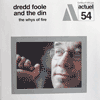 A strange album that, try as I may, I can't help but like. It's theposturing evident on the packaging that's off-putting, borrowed cachetfrom old-fashioned fine art records (that's just sooo SYR) and oldschool improv. I guess that stuff works to an extent and you can'tblame folk for wanting to sell their disks. The music, on the otherhand, is handily distinct and functional. At heart its live recordingof a psychedelic group improvisation blow-out: three guitars (ThurstonMoore, Patrick Best and Jack Rose) plus Indian strings (Mike Gangloff)build a great big flat wall of atonal drone, skitter and feedbackagainst which Chris Corsano drums up a furious pounding storm andthrough which Foole's (Dan Ireton) heavily echoed and reverberatedvocal droning, shouting, and wailing tunelessly wanders. It's basicallyall noise played at a fairly static level with some embellishment.There's an impression of rather little interaction between theimprovisers for much of the way but that's looking at this the wrongway, as thought it were old-school improv (e.g. Company or AMM). Incontrast to that, what's really happening is what talented psychrockers do (did) in their long out-chorus extemporizations—the buildingup of one great big collective head-banging drone made up of as manycomponents as the band can muster. No one is trying to stand out frontin the sense of soloing or being a virtuoso and there's none of thechallenge-response approach—it's all collective action. What makes itstrange is the mix. You would be forgiven for not noticing Corsano'sdrumming, he's so low in the mix. Once you cotton on to thatcontribution the whole thing takes on a whole different aspect, turningfrom a nice little noise package into a dynamic driving rock-out.Foole's singing is primitive, musically-challenged but fairlyeffective. On most tracks he's just providing another element of thecollective din, adding color and a little humanity to the guitar ladenwhole. Emotionally powerful or aesthetically challenging he is not butthe heavy use of reverb etc. on his free-form vocalization brings anice 60s art experiment touch. I have a sense that the music isn'ttaking itself too seriously and that's also the key to enjoying it: agreat big indulgent degenerate-rock blow-out. How this release relatesto the two from the mid-80s when Ireton was collaborating with Missionof Burma alumni, I can't say, not having heard those. -
A strange album that, try as I may, I can't help but like. It's theposturing evident on the packaging that's off-putting, borrowed cachetfrom old-fashioned fine art records (that's just sooo SYR) and oldschool improv. I guess that stuff works to an extent and you can'tblame folk for wanting to sell their disks. The music, on the otherhand, is handily distinct and functional. At heart its live recordingof a psychedelic group improvisation blow-out: three guitars (ThurstonMoore, Patrick Best and Jack Rose) plus Indian strings (Mike Gangloff)build a great big flat wall of atonal drone, skitter and feedbackagainst which Chris Corsano drums up a furious pounding storm andthrough which Foole's (Dan Ireton) heavily echoed and reverberatedvocal droning, shouting, and wailing tunelessly wanders. It's basicallyall noise played at a fairly static level with some embellishment.There's an impression of rather little interaction between theimprovisers for much of the way but that's looking at this the wrongway, as thought it were old-school improv (e.g. Company or AMM). Incontrast to that, what's really happening is what talented psychrockers do (did) in their long out-chorus extemporizations—the buildingup of one great big collective head-banging drone made up of as manycomponents as the band can muster. No one is trying to stand out frontin the sense of soloing or being a virtuoso and there's none of thechallenge-response approach—it's all collective action. What makes itstrange is the mix. You would be forgiven for not noticing Corsano'sdrumming, he's so low in the mix. Once you cotton on to thatcontribution the whole thing takes on a whole different aspect, turningfrom a nice little noise package into a dynamic driving rock-out.Foole's singing is primitive, musically-challenged but fairlyeffective. On most tracks he's just providing another element of thecollective din, adding color and a little humanity to the guitar ladenwhole. Emotionally powerful or aesthetically challenging he is not butthe heavy use of reverb etc. on his free-form vocalization brings anice 60s art experiment touch. I have a sense that the music isn'ttaking itself too seriously and that's also the key to enjoying it: agreat big indulgent degenerate-rock blow-out. How this release relatesto the two from the mid-80s when Ireton was collaborating with Missionof Burma alumni, I can't say, not having heard those. -
Two new shows just for you. We have squeezed out two extended release episodes for this weekend to get you through this week. They contain mostly new songs but there's also new issues from the vaults. The first show features music from Rider/Horse, Mint Field, Robert Aiki Aubrey Lowe, Anastasia Coope, ISAN, Stone Music, La Securite, Bark Psychosis, Jon Rose, Master Wilburn Burchette, Umberto, Wand, Tim Koh, Sun An, and Memory Drawings. The second episode has music by Laibach, Melt-Banana, Chuck Johnson, X, K. Yoshimatsu, Dorothy Carter, Pavel Milyakov, Violence Gratuite, Mark Templeton, Dummy, Endon, body / negative, Midwife, Alberto Boccardi, Divine. Cow in Maui from Veronika in Vienna. Get involved: subscribe, review, rate, share with your friends, send images! |



 Jan St. Werner has a way of keeping the flavor-seal closed tight.There's a freshness to everything he gets his hands on that isdownright addictive. When Mouse on Mars broke out, they gave bliss-outelectronic the funky backbone it needed to stay interesting; likewisein Microstoria, Werner contributed a tender roundness to Markus Popp'sdigital landscape. Scryptis the third album from St. Werner's more abstract solo projectLithops, and where the first two treaded heavily in a shaky land ofbedroom concréte and dissected electro, Scrypt marks aninvigoration of the Lithops sound.The obscure cover-art and vaguely archaic title paint an accuratepicture of the music inside. The common thread is, more than ever, St.Werner's layering of distorted drones and static pulse. This timearound, however, the cohesion achieved makes the even most complextracks sound elemental, as if gathered from the air. The first track,"Generator," acts as an overture, condensing the gamut of distortedplanes in which almost everything here is submerged. Throughout thedisc, as melody emerges from the fray, it is constructed of rich,droning bass and frayed, stuttering high notes. While on earlierLithops releases a deliberately "underproduced" quality permeated, on Scrypt,it has been tempered by a refined attention to placement. A cleartouchstone for much of this album would be the music of ChristianFennesz, except here somber guitars are replaced by bits of saccharinepop bliss and plodding bass notes, fractured in and out of the waves ofstatic. "Graind" contains a melodic hook that would easily feel at homein a DAT Politics tune.As always with St. Werner and the rest of his Sonig buddies, theelement of surprise is at a premium. Horns, woodwinds, trashcanpercussion, plunking guitars, and all variety of concréte pandering areat work creating music that is at once playful, challenging, and evenmelancholic. As with recent Mouse on Mars material, St. Werner standsalone here in his ability to rend unorthodox rhythms from the mostdiverse sonic tidbits and to bend these around an equally impressivearray of instruments. The results are never boring, and this is thebest Lithops music yet.
Jan St. Werner has a way of keeping the flavor-seal closed tight.There's a freshness to everything he gets his hands on that isdownright addictive. When Mouse on Mars broke out, they gave bliss-outelectronic the funky backbone it needed to stay interesting; likewisein Microstoria, Werner contributed a tender roundness to Markus Popp'sdigital landscape. Scryptis the third album from St. Werner's more abstract solo projectLithops, and where the first two treaded heavily in a shaky land ofbedroom concréte and dissected electro, Scrypt marks aninvigoration of the Lithops sound.The obscure cover-art and vaguely archaic title paint an accuratepicture of the music inside. The common thread is, more than ever, St.Werner's layering of distorted drones and static pulse. This timearound, however, the cohesion achieved makes the even most complextracks sound elemental, as if gathered from the air. The first track,"Generator," acts as an overture, condensing the gamut of distortedplanes in which almost everything here is submerged. Throughout thedisc, as melody emerges from the fray, it is constructed of rich,droning bass and frayed, stuttering high notes. While on earlierLithops releases a deliberately "underproduced" quality permeated, on Scrypt,it has been tempered by a refined attention to placement. A cleartouchstone for much of this album would be the music of ChristianFennesz, except here somber guitars are replaced by bits of saccharinepop bliss and plodding bass notes, fractured in and out of the waves ofstatic. "Graind" contains a melodic hook that would easily feel at homein a DAT Politics tune.As always with St. Werner and the rest of his Sonig buddies, theelement of surprise is at a premium. Horns, woodwinds, trashcanpercussion, plunking guitars, and all variety of concréte pandering areat work creating music that is at once playful, challenging, and evenmelancholic. As with recent Mouse on Mars material, St. Werner standsalone here in his ability to rend unorthodox rhythms from the mostdiverse sonic tidbits and to bend these around an equally impressivearray of instruments. The results are never boring, and this is thebest Lithops music yet. 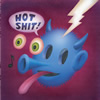 We live in interesting times, if I may make a grand understatement, andit's only natural that current events find their way into the realms ofart and music. Expressions of disillusionment with the currentpresidential administration, its policies, and the state of globalpolitics in general permeate this disc. It doesn't sound like a"message" record, though, and it's not a call to arms. Hot Shitis a documentation of the personal impressions of Sam Coomes and JanetWeiss, one which I'm sure is shared by many. They are worried aboutgovernment control, unnecessary wars, the erosion of freedom, and theconfusing jumble of fact and fiction that loads the world's newspaperstoday. On the title track, they immediately begin with a question."Wild goose or Holy Grail? / Red Herring or the Great White Whale?" Inessence, what's it all about? It is this sense of confusion that drivesmuch of the feelings behind the album. On "Seven Years Gone," Coomeseven admits about the newspapers that say America supports thepresident and the war on terror: "How much is lies and how much justunwise, I can't say." While Quasi is capable of detailing their concernthrough clever storytelling, their discernment occasionally lapses."White Devil's Dream," co-penned by Coomes and Weiss is the most directattack on the theme, calling out the names of the members of George W.Bush's administration and telling them to "fuck off." It's hardly anuanced critique on their policies and beliefs, but it does convey thefrustrated anger that the pair (and no doubt the others who will warmlyembrace this tirade) feels. Still, it is an unfortunate breach of thesubtlety and craft that Quasi displays on the other tracks. "Master andDog" is an allegory that accuses world leaders (this time, not by name)of taking their people by the leash and forcing them into conflict.Neither side of the political spectrum is spared, as Coomes sings "Theelephant wields the rod / while the donkey throws you a bone / I'drather have a bone than a beating, I suppose / but either way it'sstill just master and dog." The lesser of two evils, indeed. Musically,Quasi is on target. They give off a loose, stompy rock sound thatperfectly suits Coomes vocals and Weiss' backup. It's particularlyupbeat for the subject matter. On "No One," they bring in wistfulstrings to add a poignant flavor to the track. It's a simple piece,hiding from all the world's troubles and seeking comfort and safety inthe warm embrace of a loved one. The sentiment and delivery is trulyaffecting. After the breakdown that is captured in "White Devil'sDream," the album takes a much more positive tone, emphasizing theimportance of individual vigilance and group strength in the face ofthese disheartening times. Hot Shit is a sympathetic record,one that echoes a lot of the more common thoughts people are struck bywhen confronted with the flood of graphic images and muddledinformation. It's a protest, sure, but one that doesn't stem from emptymotivations or sloganeering, instead coming from genuine emotion.
We live in interesting times, if I may make a grand understatement, andit's only natural that current events find their way into the realms ofart and music. Expressions of disillusionment with the currentpresidential administration, its policies, and the state of globalpolitics in general permeate this disc. It doesn't sound like a"message" record, though, and it's not a call to arms. Hot Shitis a documentation of the personal impressions of Sam Coomes and JanetWeiss, one which I'm sure is shared by many. They are worried aboutgovernment control, unnecessary wars, the erosion of freedom, and theconfusing jumble of fact and fiction that loads the world's newspaperstoday. On the title track, they immediately begin with a question."Wild goose or Holy Grail? / Red Herring or the Great White Whale?" Inessence, what's it all about? It is this sense of confusion that drivesmuch of the feelings behind the album. On "Seven Years Gone," Coomeseven admits about the newspapers that say America supports thepresident and the war on terror: "How much is lies and how much justunwise, I can't say." While Quasi is capable of detailing their concernthrough clever storytelling, their discernment occasionally lapses."White Devil's Dream," co-penned by Coomes and Weiss is the most directattack on the theme, calling out the names of the members of George W.Bush's administration and telling them to "fuck off." It's hardly anuanced critique on their policies and beliefs, but it does convey thefrustrated anger that the pair (and no doubt the others who will warmlyembrace this tirade) feels. Still, it is an unfortunate breach of thesubtlety and craft that Quasi displays on the other tracks. "Master andDog" is an allegory that accuses world leaders (this time, not by name)of taking their people by the leash and forcing them into conflict.Neither side of the political spectrum is spared, as Coomes sings "Theelephant wields the rod / while the donkey throws you a bone / I'drather have a bone than a beating, I suppose / but either way it'sstill just master and dog." The lesser of two evils, indeed. Musically,Quasi is on target. They give off a loose, stompy rock sound thatperfectly suits Coomes vocals and Weiss' backup. It's particularlyupbeat for the subject matter. On "No One," they bring in wistfulstrings to add a poignant flavor to the track. It's a simple piece,hiding from all the world's troubles and seeking comfort and safety inthe warm embrace of a loved one. The sentiment and delivery is trulyaffecting. After the breakdown that is captured in "White Devil'sDream," the album takes a much more positive tone, emphasizing theimportance of individual vigilance and group strength in the face ofthese disheartening times. Hot Shit is a sympathetic record,one that echoes a lot of the more common thoughts people are struck bywhen confronted with the flood of graphic images and muddledinformation. It's a protest, sure, but one that doesn't stem from emptymotivations or sloganeering, instead coming from genuine emotion. 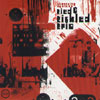 It's been two years since German electronic/jazz collective Tied and Tickled Trio released their fine Electric Avenue Tapes disc, and with good reason. In part, the core rhythm section of brothers Micha and Markus Acher had spent a great deal of time perfecting the sound of their other group the Notwist's last disc, while also recording and performing with separate projects Ms John Soda and Lali Puna.
It's been two years since German electronic/jazz collective Tied and Tickled Trio released their fine Electric Avenue Tapes disc, and with good reason. In part, the core rhythm section of brothers Micha and Markus Acher had spent a great deal of time perfecting the sound of their other group the Notwist's last disc, while also recording and performing with separate projects Ms John Soda and Lali Puna. Guitarist Stephen O'Malley has played in a number of twistedsludge-metal bands — notably Thorr's Hammer, Blind Idiot God andBurning Witch — but his work in Sunn O))) is what has gained himnotoriety outside of the insular indie-metal scene. Sunn O)))'soppressive, effects-laden guitar drones have impressed devotees ofnoise and experimental music, as well as listeners of post-industrialand neo-psychedelia. Stephen O'Malley's new band Khanate shares much ofthe shattering doomcore of Sunn O))), without the strict musicalasceticism. The addition of James Plotkin on bass,singer Alan Dubin (of OLD) and drummer Tim Wyskida fills out the sound,bringing Khanate out of the depths of harsh, noisy minimalism and intothe realm of more-or-less traditional metal. Khanate's self-titleddebut for Southern Lord was a slow-motion tribute to the Nordic deathmetal of bands like Burzum, Dimmu Borgir and Borknagar. This new 12" onLoad Records, home to many terrifically bizarre post-metal bands,contains a remix of the song "No Joy" from the first album, and a newtrack "Dead" on the b-side. James Plotkin's added touches to thefrighteningly macabre "No Joy" turn the song into a brutal,mind-crushing dirge, a post-apocalyptic tribute to The Stooges' "NoFun." No fun, indeed, as the nine-minute track is warped and extendedfor maximum oppression and mental violence. O'Malley's guitar deliversthe painstakingly sluggish, catastrophic riffs that caused Julian Copeto exclaim that "slow is the new loud." The drums are also playedachingly slow, with monolithic forcefulness in every excruciating beat.Dubin's high-pitched shriek-singing shares the same terrifying,evocative morbidity as Tom Araya's Reign in Blood-era vocalsfor Slayer: "No joy/No fucking joy/Only hate." Plotkin's extraproduction touches intensify the song's darkness and brutality, addingelectronic stutters, time-stretching, creepy whispers and ghostlymetallic phasing. The b-side, "Dead," is a previously unreleased tracktaken from the same sessions as their upcoming full-length album onSouthern Lord. It is a similarly oppressive slab of queasy, ambientdoomcore, but this time Dubin's desolate vocals are more emphasized inthe mix: "I was visible/But not seen/Deserted/Alone." Plotkin addsunexpected digital smudges, squalls and glitches to this track,indicating a more experimental direction for the band. What I find soimpressive about Khanate is their exaggerated but ascetic musicalvocabulary: each element is carefully formulated to impart maximumdread, pathos and painful aggression. It's extremely theatrical,completely original, and ultimately very satisfying.
Guitarist Stephen O'Malley has played in a number of twistedsludge-metal bands — notably Thorr's Hammer, Blind Idiot God andBurning Witch — but his work in Sunn O))) is what has gained himnotoriety outside of the insular indie-metal scene. Sunn O)))'soppressive, effects-laden guitar drones have impressed devotees ofnoise and experimental music, as well as listeners of post-industrialand neo-psychedelia. Stephen O'Malley's new band Khanate shares much ofthe shattering doomcore of Sunn O))), without the strict musicalasceticism. The addition of James Plotkin on bass,singer Alan Dubin (of OLD) and drummer Tim Wyskida fills out the sound,bringing Khanate out of the depths of harsh, noisy minimalism and intothe realm of more-or-less traditional metal. Khanate's self-titleddebut for Southern Lord was a slow-motion tribute to the Nordic deathmetal of bands like Burzum, Dimmu Borgir and Borknagar. This new 12" onLoad Records, home to many terrifically bizarre post-metal bands,contains a remix of the song "No Joy" from the first album, and a newtrack "Dead" on the b-side. James Plotkin's added touches to thefrighteningly macabre "No Joy" turn the song into a brutal,mind-crushing dirge, a post-apocalyptic tribute to The Stooges' "NoFun." No fun, indeed, as the nine-minute track is warped and extendedfor maximum oppression and mental violence. O'Malley's guitar deliversthe painstakingly sluggish, catastrophic riffs that caused Julian Copeto exclaim that "slow is the new loud." The drums are also playedachingly slow, with monolithic forcefulness in every excruciating beat.Dubin's high-pitched shriek-singing shares the same terrifying,evocative morbidity as Tom Araya's Reign in Blood-era vocalsfor Slayer: "No joy/No fucking joy/Only hate." Plotkin's extraproduction touches intensify the song's darkness and brutality, addingelectronic stutters, time-stretching, creepy whispers and ghostlymetallic phasing. The b-side, "Dead," is a previously unreleased tracktaken from the same sessions as their upcoming full-length album onSouthern Lord. It is a similarly oppressive slab of queasy, ambientdoomcore, but this time Dubin's desolate vocals are more emphasized inthe mix: "I was visible/But not seen/Deserted/Alone." Plotkin addsunexpected digital smudges, squalls and glitches to this track,indicating a more experimental direction for the band. What I find soimpressive about Khanate is their exaggerated but ascetic musicalvocabulary: each element is carefully formulated to impart maximumdread, pathos and painful aggression. It's extremely theatrical,completely original, and ultimately very satisfying.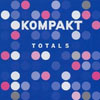 The sinfully underhyped Kompakt label has a history of high-qualityreleases in the tech-house and micro-house subgenres, heralding theso-called Cologne Sound that those in the know cannot get enough of.While many house music peers seem content to release exclusively onvinyl, Kompakt is a trendsetter, regularly releasing what now appearsto be annual editions in the Total series of unmixed compilations. Featuring tracks from 12" singles as well as previously unreleased material, Total 5is the latest installment of top-notch tracks from the label'srespectable roster. SCSI-9, a Russian duo with several releases on theacclaimed Forcetracks imprint, opens the disc with "All She Wants Is,"a deep cut structured around a repetitious and incredibly catchy vocalhook and sizzling with a minimal drum loop and various synthembellishments. Superpitcher, who appeared on Total 4 with anelectroclashy number, transform the simplistic house groove of"Mushroom" into a beautiful and rather serene nature scene for theears, complete with simulated water droplets. While these two may straysomewhat from the well-beaten path of Cologne house, contributions fromPhong Sui, M. Mayer, and Reinhart Voigt present solid tunes bubblingover with warm synth pads and steady mechanical beats. If I had tochoose the highlight from the bunch, it would result in an admirabledraw. Potential techno "It boy" T. Raumschmiere of Novamute andShitkatapult fame drops a gooey track of the warbly bass and robot funkhe is currently championing. In contrast, The Orb co-conspirator andSun Electric mastermind Thomas Fehlmann makes a breathtaking appearancewith the gorgeous soft textures and tones of "Radeln." With captivatingdubby echoes and a genuine clickhouse groove, "Radeln" grew on meconsiderably more with each listen. You go buy now. I go eat sandwich.
The sinfully underhyped Kompakt label has a history of high-qualityreleases in the tech-house and micro-house subgenres, heralding theso-called Cologne Sound that those in the know cannot get enough of.While many house music peers seem content to release exclusively onvinyl, Kompakt is a trendsetter, regularly releasing what now appearsto be annual editions in the Total series of unmixed compilations. Featuring tracks from 12" singles as well as previously unreleased material, Total 5is the latest installment of top-notch tracks from the label'srespectable roster. SCSI-9, a Russian duo with several releases on theacclaimed Forcetracks imprint, opens the disc with "All She Wants Is,"a deep cut structured around a repetitious and incredibly catchy vocalhook and sizzling with a minimal drum loop and various synthembellishments. Superpitcher, who appeared on Total 4 with anelectroclashy number, transform the simplistic house groove of"Mushroom" into a beautiful and rather serene nature scene for theears, complete with simulated water droplets. While these two may straysomewhat from the well-beaten path of Cologne house, contributions fromPhong Sui, M. Mayer, and Reinhart Voigt present solid tunes bubblingover with warm synth pads and steady mechanical beats. If I had tochoose the highlight from the bunch, it would result in an admirabledraw. Potential techno "It boy" T. Raumschmiere of Novamute andShitkatapult fame drops a gooey track of the warbly bass and robot funkhe is currently championing. In contrast, The Orb co-conspirator andSun Electric mastermind Thomas Fehlmann makes a breathtaking appearancewith the gorgeous soft textures and tones of "Radeln." With captivatingdubby echoes and a genuine clickhouse groove, "Radeln" grew on meconsiderably more with each listen. You go buy now. I go eat sandwich.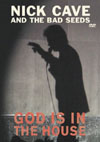 As the cost of technology comes down consistently, it's puzzling to
note that few labels are taking advantage of the marvelous
opportunities before them. This is a fantastic example of a music DVD
done properly, despite it being a few years after the album release of No More Shall We Part.
Most of the material comes from that album, but considering other live
videos available from the Bad Seeds, it serves as a fine addition to
the library. Here, the Bad Seeds are captured at a concert in Lyon,
France (2001). It just happens to be the last tour that Neubauten's
Blixa Bargeld is supposed to perform on and here, he, along with Mick
Harvey and Dirty Three's Warren Ellis are just as entertaining to watch
as Nick Cave, himself. Cave may not quite ever become a household name
but he is most certainly becoming a musical legend. Cave's ballads
speak volumes and his stage presence is intense, much like an
evangelical preacher. The experience of seeing the Bad Seeds live is so
intense and dramatic, that it blows away all expectations from merely
listening to the records at home. Even a lukewarm album can achieve a
thunderous accomplishment as the Bad Seeds are all fantastic players
and spend so much time touring. The concert is elegantly shot and
edited with a good amount of inclusion of the entire group, and the
sound is excellent. In addition, Mute thankfully decided not to hold
back on this release and included all three music videos from the album
along with a short documentary on the recording of the album. Coupled
with the album and the experience is complete. I can hope that it's
only a matter of time that labels will release DVDs like this WITH the
CD of said album. (But in all honesty, expect it to be a Japanese
"perk" for about 10 years before the rest of the world catches on.)
As the cost of technology comes down consistently, it's puzzling to
note that few labels are taking advantage of the marvelous
opportunities before them. This is a fantastic example of a music DVD
done properly, despite it being a few years after the album release of No More Shall We Part.
Most of the material comes from that album, but considering other live
videos available from the Bad Seeds, it serves as a fine addition to
the library. Here, the Bad Seeds are captured at a concert in Lyon,
France (2001). It just happens to be the last tour that Neubauten's
Blixa Bargeld is supposed to perform on and here, he, along with Mick
Harvey and Dirty Three's Warren Ellis are just as entertaining to watch
as Nick Cave, himself. Cave may not quite ever become a household name
but he is most certainly becoming a musical legend. Cave's ballads
speak volumes and his stage presence is intense, much like an
evangelical preacher. The experience of seeing the Bad Seeds live is so
intense and dramatic, that it blows away all expectations from merely
listening to the records at home. Even a lukewarm album can achieve a
thunderous accomplishment as the Bad Seeds are all fantastic players
and spend so much time touring. The concert is elegantly shot and
edited with a good amount of inclusion of the entire group, and the
sound is excellent. In addition, Mute thankfully decided not to hold
back on this release and included all three music videos from the album
along with a short documentary on the recording of the album. Coupled
with the album and the experience is complete. I can hope that it's
only a matter of time that labels will release DVDs like this WITH the
CD of said album. (But in all honesty, expect it to be a Japanese
"perk" for about 10 years before the rest of the world catches on.) As principal early players in the '90s computer music scene, fetishising digital audio and austere CGI graphics with the best of them, it's fitting that Farmers Manual should be behind RLA, the latest and most uncompromising expression so far of the Merzbox mentality. Technically, RLA is a dual layer DVD9, NTSC, region-free DVD with a running time of three days, 21 hours and 38 seconds. It's as exhaustive as possible a collection of everything to do with Farmers Manual's live shows since 1995: nearly four days of MP3s (from "several artists, but mostly FM and related folks") along with accompanying JPEGs of the shows, their locations, gig flyers, stage passes, press reviews, mailing list write-ups, and even a few movie files. The icing on the cake is that, inserted in a computer's DVD drive, it auto-plays some baffling and unexplained handheld camcorder footage of FM knocking a wall down in a basement studio, then later hanging around in an apartment with a cat.
As principal early players in the '90s computer music scene, fetishising digital audio and austere CGI graphics with the best of them, it's fitting that Farmers Manual should be behind RLA, the latest and most uncompromising expression so far of the Merzbox mentality. Technically, RLA is a dual layer DVD9, NTSC, region-free DVD with a running time of three days, 21 hours and 38 seconds. It's as exhaustive as possible a collection of everything to do with Farmers Manual's live shows since 1995: nearly four days of MP3s (from "several artists, but mostly FM and related folks") along with accompanying JPEGs of the shows, their locations, gig flyers, stage passes, press reviews, mailing list write-ups, and even a few movie files. The icing on the cake is that, inserted in a computer's DVD drive, it auto-plays some baffling and unexplained handheld camcorder footage of FM knocking a wall down in a basement studio, then later hanging around in an apartment with a cat. Mike Patton has a cult fanbase, mostly due to his vocal gymnastics andhis unique sensibilities when fronting a group — c.f. Fantomas, Mr.Bungle, et al — but with Tomahawk he's very much in Rock Band Membermode, not acting as the circus ringleader. This can be a great thing,as the new Tomahawk album shows. The first Tomahawk album was full of aviolent starts and sudden stops but Mit Gasis a 40 minute sampling of smoother (if still bizarre) Tomahawk pieces.Band leader Duane Dennison (Jesus Lizard) continues to lay down acollection of sneaky guitar riffs and licks over the thick, solidlayers of drums and bass guitar. The album's opener, "Birdsong," beginswith imposing bass drones, ominous slide guitar notes and birdsongsamples until a minute in, when the bass comes in and lays the albumbare as a rock and roll record. The guitar sounds sparse throughout therecord, with judicious use of effects and guitar wankery and a fewelectronic sounds for texture. The combination of the guitar's timbreand the band's rocking gives the record an immediacy that I haven'theard in a lot of recent "rock" music. The album has lots of highpoints, and comes across as more comfortable and cohesive thanTomahawk's debut album. There's no doubt that playing live has made theband members more comfortable with each other. There are moments offunkiness, like the wicked "Harelip" with its funky bass and slinkyguitar and Patton's comic crooning "I am the Harelip/Give me one morekiss," and right between the jittering electronic "Capt. Midnight" withits bombastic bridge and guitar that belongs in a David Lynch movie.The pounding "When The Stars Begin To Fall" is followed by the soothingballad "Desastre Natural," equipped with accusatory lyrics sung inspanish. The album comes to an end with "Harem Clowns" and "Aktion13F14." The former is a moody instrumental which features a sampled andrepeated phrase, "I don't know how to read notes," over and over again.It leads into the latter, where a robotic voice reads hand-to-handcombat "how-to" instructions over a hypnotic bassline. Everythingeventually collapses into a clusterfuck of noise followed by a silenceand a beautiful short guitar piece. Fading into nothing is a perfectway to finish off an album with so many peaks. -
Mike Patton has a cult fanbase, mostly due to his vocal gymnastics andhis unique sensibilities when fronting a group — c.f. Fantomas, Mr.Bungle, et al — but with Tomahawk he's very much in Rock Band Membermode, not acting as the circus ringleader. This can be a great thing,as the new Tomahawk album shows. The first Tomahawk album was full of aviolent starts and sudden stops but Mit Gasis a 40 minute sampling of smoother (if still bizarre) Tomahawk pieces.Band leader Duane Dennison (Jesus Lizard) continues to lay down acollection of sneaky guitar riffs and licks over the thick, solidlayers of drums and bass guitar. The album's opener, "Birdsong," beginswith imposing bass drones, ominous slide guitar notes and birdsongsamples until a minute in, when the bass comes in and lays the albumbare as a rock and roll record. The guitar sounds sparse throughout therecord, with judicious use of effects and guitar wankery and a fewelectronic sounds for texture. The combination of the guitar's timbreand the band's rocking gives the record an immediacy that I haven'theard in a lot of recent "rock" music. The album has lots of highpoints, and comes across as more comfortable and cohesive thanTomahawk's debut album. There's no doubt that playing live has made theband members more comfortable with each other. There are moments offunkiness, like the wicked "Harelip" with its funky bass and slinkyguitar and Patton's comic crooning "I am the Harelip/Give me one morekiss," and right between the jittering electronic "Capt. Midnight" withits bombastic bridge and guitar that belongs in a David Lynch movie.The pounding "When The Stars Begin To Fall" is followed by the soothingballad "Desastre Natural," equipped with accusatory lyrics sung inspanish. The album comes to an end with "Harem Clowns" and "Aktion13F14." The former is a moody instrumental which features a sampled andrepeated phrase, "I don't know how to read notes," over and over again.It leads into the latter, where a robotic voice reads hand-to-handcombat "how-to" instructions over a hypnotic bassline. Everythingeventually collapses into a clusterfuck of noise followed by a silenceand a beautiful short guitar piece. Fading into nothing is a perfectway to finish off an album with so many peaks. - 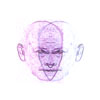 For an album that is right at forty-six minutes long, it sure does seemto last an enternity. The entire record is basically a series of tonesaccompanied by various passages concerned with or describing sexualperversions. At first this seemed like an exciting enough prospect:Andrew Liles associates Aural Anagramwith the various productions of Hans Bellmer. Bellmer was one of thefirst post-Dada surrealists, his self-portrait appears on the cover andI assume that the artwork in the liner notes is either inspired ordrawn by him. The primary sketch on the liner notes depicts a nudewoman on her hands and knees with her lower torso "x-rayed" to revealher womb and sexual organs. At the same time, she is pleasuring threedifferent men who are shown only by the presence of their penis. It's astrange image to be sure, but none of the sexuality in the picturemakes it into the music in any way. Each track sounds remarkably thesame with various vocal samples describing various perversities orsexual observations made from a nearly medical standpoint. Nothingchanges throughout the duration of the recording: many of the tonesused have the same color and feel throughout and much of the vocalsamples simply repeat themselves into boring oblivion. It sounds morelike one long recording than a series of nine compositions inspired byan explicit artist. It may be my hormones talking, but with a premisslike this, the album certainly could've been more exciting and retainedits rather dark and ominous atmosphere. In the end, that is what makeseverything about this recording so dull: it's too dark for too long andwith little to no variation in the bleakness of it all. It's aninteresting exploration of an artist and an idea but it fails as acomposition as a result of being far too limited in scope.
For an album that is right at forty-six minutes long, it sure does seemto last an enternity. The entire record is basically a series of tonesaccompanied by various passages concerned with or describing sexualperversions. At first this seemed like an exciting enough prospect:Andrew Liles associates Aural Anagramwith the various productions of Hans Bellmer. Bellmer was one of thefirst post-Dada surrealists, his self-portrait appears on the cover andI assume that the artwork in the liner notes is either inspired ordrawn by him. The primary sketch on the liner notes depicts a nudewoman on her hands and knees with her lower torso "x-rayed" to revealher womb and sexual organs. At the same time, she is pleasuring threedifferent men who are shown only by the presence of their penis. It's astrange image to be sure, but none of the sexuality in the picturemakes it into the music in any way. Each track sounds remarkably thesame with various vocal samples describing various perversities orsexual observations made from a nearly medical standpoint. Nothingchanges throughout the duration of the recording: many of the tonesused have the same color and feel throughout and much of the vocalsamples simply repeat themselves into boring oblivion. It sounds morelike one long recording than a series of nine compositions inspired byan explicit artist. It may be my hormones talking, but with a premisslike this, the album certainly could've been more exciting and retainedits rather dark and ominous atmosphere. In the end, that is what makeseverything about this recording so dull: it's too dark for too long andwith little to no variation in the bleakness of it all. It's aninteresting exploration of an artist and an idea but it fails as acomposition as a result of being far too limited in scope. 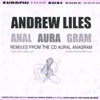 On the other hand, the remix album included with the first one-hundred copies of Aural Anagramis a more cohesive, varied, and interesting exploration of droningsounds and sexual expression. Instead of being a series of nine trackslike the original was, Anal Aura Gram is four tracks tiedtogether very closely so that the recording can be experienced as awhole. By cutting the album down by ten minutes and condensing much ofthe original material, Liles creates an almost deafening world. Itisn't deafening because it's overly loud or overpowering in any way,it's just that the sounds used produce the aural equivalent ofclaustrophobia. Every sound has a tactitle quality, whether it isfeathery softness or the cold feeling of making a discomfortingobservation. More melodic elements are present than on the original andnot so much time is devoted to near-silence or frustrating repetition.The vocal samples are used more sparingly and multiple textures areused throughout so that nothing overstays its welcome. This sort ofattention to detail adds to the eerie and dire feelings that wereattempted on the original mix: various melodic tones float like bubblesand are flourished by rolling sparkles in piano-like ascents anddescents. Small buzz-saws cut away quietly in the background whileother alien sounds stutter and chop their away across the soundspectrum. Here and there feminine moans and abrupt cries appear anddisappear within the mix creating a vaguely erotic tension whilemaintaining a secretive tone that hints at violence, destruction, and(somehow) infidelity. There are fewer overtly sexual references made,but the ones used are both exciting and unsettling. The remixes areeverything Aural Anagram could've (and should've) been, so those interested should grab a copy before they all disappear.
On the other hand, the remix album included with the first one-hundred copies of Aural Anagramis a more cohesive, varied, and interesting exploration of droningsounds and sexual expression. Instead of being a series of nine trackslike the original was, Anal Aura Gram is four tracks tiedtogether very closely so that the recording can be experienced as awhole. By cutting the album down by ten minutes and condensing much ofthe original material, Liles creates an almost deafening world. Itisn't deafening because it's overly loud or overpowering in any way,it's just that the sounds used produce the aural equivalent ofclaustrophobia. Every sound has a tactitle quality, whether it isfeathery softness or the cold feeling of making a discomfortingobservation. More melodic elements are present than on the original andnot so much time is devoted to near-silence or frustrating repetition.The vocal samples are used more sparingly and multiple textures areused throughout so that nothing overstays its welcome. This sort ofattention to detail adds to the eerie and dire feelings that wereattempted on the original mix: various melodic tones float like bubblesand are flourished by rolling sparkles in piano-like ascents anddescents. Small buzz-saws cut away quietly in the background whileother alien sounds stutter and chop their away across the soundspectrum. Here and there feminine moans and abrupt cries appear anddisappear within the mix creating a vaguely erotic tension whilemaintaining a secretive tone that hints at violence, destruction, and(somehow) infidelity. There are fewer overtly sexual references made,but the ones used are both exciting and unsettling. The remixes areeverything Aural Anagram could've (and should've) been, so those interested should grab a copy before they all disappear.
